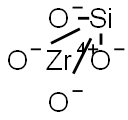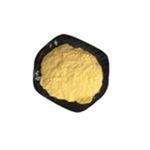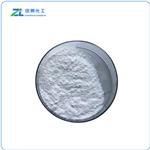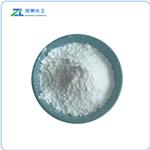Description
Zircon (ZrSiO4) is an accessory nesosilicate mineral found in
granites and, due to its high Mohs hardness of 7.5 and chemical inertness, it concentrates in
the weathering products of mother igneous rocks such as in alluvial placer deposits and
beach sands. Because of its chemical inertness and high melting point, zircon is wetted less
easily by molten metal, producing smoother surfaces on iron, high alloy steel, aluminum,
and bronze casting.
Chemical Properties
Zirconium silicate is a colorless tetragonal crystals (when pure); presence of impurities forms various colors; density 4.56 g/cm3; hardness 7.5 Mohs; dissociates to ZrO2 and SiO2 above 1,540°C; melts at 2,550°C; insoluble in water, acids, aqua regia, and alkalies; inert in most chemicals. Zirconium silicate is used as an additive to glass, in ceramic tiles, in ultrafiltration membranes, and as a dental abrasive.
Uses
Zirconium silicate (ZrSiO4) is one form of the mineral whose crystals when polished are
known as cubic zircons, which resemble diamond gemstones.
Preparation
Zirconium silicate occurs in nature as mineral zircon. Ore is mined from natural deposits and concentrated by various techniques (See Zirconium, Recovery). It is separated from sand by electrostatic and electromagnetic methods. Also, the compound can be made by fusion of SiO2 and ZrO2 in an arc furnace, or by reacting a zirconium salt with sodium silicate in aqueous solution.
Application
Zirconium silicate is used for manufacturing refractory materials for applications where resistance to corrosion by alkali materials is required. It is also used in production of some ceramics, enamels, and ceramic glazes. In enamels and glazes it serves as an opacifier. It can be also present in some cements. Another use of zirconium silicate is as beads for milling and grinding. Thin films of zirconium silicate and hafnium silicate produced by chemical vapor deposition. Potential alternative gate dielectric to silica. In Europe in cosmetic creams and powders.
Definition
Zirconium silicate is a naturally occurring silicateof zirconium, ZrSiO4, used as a gemstone.The colour depends in smallamounts of other metals and may bered, brown, yellow, or green. Redgem-quality zircon is sometimescalled jacinth; gem-quality zirconswith other colours are called jargoons.There is also a naturally occurringcolourless variety. Zircongems can be given other colours, ormade colourless, by heat treatment.The colourless varieties (either naturalor treated) are sometimes calledMatura diamonds (after Matura in SriLanka). The name 'zircon' is often erroneouslyapplied to a synthetic formof the oxide cubic zircona, which isused as a diamond substitute.
Materials Uses
The largest use of zircon (Zirconium silicate) is as foundry sand, where zircon is used as the
basic mold material, as facing material on mold cores, and in ram mixes. Zircon-sand molds
have greater thermal shock resistance and better dimensional stability than quartz-sand
molds. Zircon grains are usually bonded with sodium silicate.




